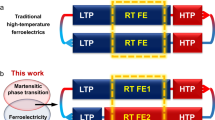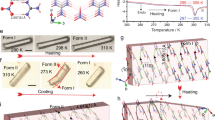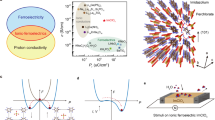Abstract
Ferroelectrics are used in a wide range of applications, including memory elements, capacitors and sensors. Recently, molecular ferroelectric crystals have attracted interest as viable alternatives to conventional ceramic ferroelectrics because of their solution processability and lack of toxicity. Here we show that a class of molecular compounds—known as plastic crystals—can exhibit ferroelectricity if the constituents are judiciously chosen from polar ionic molecules. The intrinsic features of plastic crystals, for example, the rotational motion of molecules and phase transitions with lattice-symmetry changes, provide the crystals with unique ferroelectric properties relative to those of conventional molecular crystals. This allows a flexible alteration of the polarization axis direction in a grown crystal by applying an electric field. Owing to the tunable nature of the crystal orientation, together with mechanical deformability, this type of molecular crystal represents an attractive functional material that could find use in a diverse range of applications.
This is a preview of subscription content, access via your institution
Access options
Subscribe to this journal
Receive 12 print issues and online access
$259.00 per year
only $21.58 per issue
Buy this article
- Purchase on Springer Link
- Instant access to full article PDF
Prices may be subject to local taxes which are calculated during checkout





Similar content being viewed by others
References
Lines, M. E. & Glass, A. M. Principles and Applications of Ferroelectrics and Related Materials (Oxford Univ. Press, 1977).
Horiuchi, S. & Tokura, Y. Organic ferroelectrics. Nature Mater. 7, 357–366 (2008).
Tayi, A. S., Kaeser, A., Matsumoto, M., Aida, T. & Stupp, S. I. Supramolecular ferroelectrics. Nature Chem. 7, 281–294 (2015).
Tokura, Y. et al. Domain-wall dynamics in organic charge-transfer compounds with one-dimensional ferroelectricity. Phys. Rev. Lett. 63, 2405–2408 (1989).
Katrusiak, A. & Szafrański, M. Ferroelectricity in NH···N hydrogen bonded crystals. Phys. Rev. Lett. 82, 576–579 (1999).
Horiuchi, S. et al. Ferroelectricity near room temperature in co-crystals of nonpolar organic molecules. Nature Mater. 4, 163–166 (2005).
Horiuchi, S. et al. Above-room-temperature ferroelectricity in a single-component molecular crystal. Nature 463, 789–792 (2010).
Tayi, A. S. et al. Room-temperature ferroelectricity in supramolecular networks of charge-transfer complexes. Nature 488, 485–489 (2012).
Fu, D.-W. et al. Diisopropylammonium bromide is a high-temperature molecular ferroelectric crystal. Science 339, 425–428 (2013).
Ling, M. M. & Bao, Z. Thin film deposition, patterning, and printing in organic thin film transistors. Chem. Mater. 16, 4824–4840 (2004).
Gundlach, D. J. et al. Contact-induced crystallinity for high-performance soluble acene-based transistors and circuits. Nature Mater. 7, 216–221 (2008).
Gavezzotti, A. & Simonetta, M. Crystal chemistry in organic solids. Chem. Rev. 82, 1–13 (1982).
Fyfe, C. A. Solid State NMR for Chemists (CFC, 1983).
Vogelsberg, C. S. & Garcia-Garibay, M. A. Crystalline molecular machines: function, phase order, dimensionality, and composition. Chem. Soc. Rev. 41, 1892–1910 (2012).
Yokokura, S. et al. Switching of transfer characteristics of an organic field-effect transistor by phase transitions: sensitive response to molecular dynamics and charge fluctuation. Chem. Mater. 27, 4441–4449 (2015).
Goetz, K. P. et al. Freezing-in orientational disorder induces crossover from thermally-activated to temperature-independent transport in organic semiconductors. Nature Commun. 5, 5642 (2014).
Harada, J. & Ogawa, K. Pedal motion in crystals. Chem. Soc. Rev. 38, 2244–2252 (2009).
Horansky, R. D. et al. Dielectric response of a dipolar molecular rotor crystal. Phys. Rev. B 72, 014302 (2005).
Harada, J., Ohtani, M., Takahashi, Y. & Inabe, T. Molecular motion, dielectric response, and phase transition of charge-transfer crystals: acquired dynamic and dielectric properties of polar molecules in crystals. J. Am. Chem. Soc. 137, 4477–4486 (2015).
Akutagawa, T. et al. Ferroelectricity and polarity control in solid-state flip-flop supramolecular rotators. Nature Mater. 8, 342–347 (2009).
Timmermans, J. Plastic crystals: a historical review. J. Phys. Chem. Solids 18, 1–8 (1961).
Sherwood, J. N. The Plastically Crystalline State: Orientationally Disordered Crystals (Wiley, 1979).
Brand, R., Lunkenheimer, P. & Loidl, A. Relaxation dynamics in plastic crystals. J. Chem. Phys. 116, 10386–10401 (2002).
MacFarlane, D. R., Huang, J. & Forsyth, M. Lithium-doped plastic crystal electrolytes exhibiting fast ion conduction for secondary batteries. Nature 402, 792–794 (1999).
MacFarlane, D. R. & Forsyth, M. Plastic crystal electrolyte materials: new perspectives on solid state ionics. Adv. Mater. 13, 957–966 (2001).
Pringle, J. M., Howlett, P. C., MacFarlane, D. R. & Forsyth, M. Organic ionic plastic crystals: recent advances. J. Mater. Chem. 20, 2056–2062 (2010).
Cai, H.-L. et al. 4-(Cyanomethyl)anilinium perchlorate: a new displacive-type molecular ferroelectric. Phys. Rev. Lett. 107, 147601 (2011).
Giacovazzo, C. Fundamentals of Crystallography (Oxford Univ. Press, 2002).
Parsons, S. Introduction to twinning. Acta Crystallogr. D 59, 1995–2003 (2003).
Kagawa, F. et al. Polarization switching ability dependent on multidomain topology in a uniaxial organic ferroelectric. Nano Lett. 14, 239–243 (2014).
Jaffe, B., Cook, W. R. Jr & Jaffe, H. Piezoelectric Ceramics (Academic, 1971).
Sawyer, C. B. & Tower, C. H. Rochelle salt as a dielectric. Phys. Rev. 35, 269–273 (1930).
David, W. I. F. et al. DASH: a program for crystal structure determination from powder diffraction data. J. Appl. Crystallogr. 39, 910–915 (2006).
Sheldrick, G. M. A short history of SHELX. Acta Crystallogr. A 64, 112–122 (2008).
Acknowledgements
This work was partly supported by JSPS KAKENHI Grant no. 26620054 and a Grant-in-Aid for Scientific Research on Innovative Areas ‘π-System Figuration: Control of Electron and Structural Dynamism for Innovative Functions’ (Grant no. 15H00980) from the Ministry of Education, Culture, Sports, Science and Technology, Japan. The authors thank A. Kobayashi (Hokkaido University) for access to a Bruker D8 ADVANCE powder X-ray diffractometer.
Author information
Authors and Affiliations
Contributions
J.H. conceived and designed the study, performed the crystallographic studies and wrote the manuscript. T.S. and H.O. prepared the samples and performed the hysteresis experiments. T.S. carried out the dielectric measurements and thermal analysis. Y.T. assisted with the hysteresis and dielectric experiments. H.H. and H.O. carried out the SEM. K.S., Y.S. and J.K. conducted the SHG measurements. T.I. contributed to the design of the study and supervised the project.
Corresponding authors
Ethics declarations
Competing interests
The authors declare no competing financial interests.
Supplementary information
Supplementary information
Supplementary information (PDF 969 kb)
Supplementary information
Crystallographic data for compound 1 at 300 K. (CIF 226 kb)
Supplementary information
Crystallographic data for compound 1 at 350 K. (CIF 131 kb)
Supplementary information
Crystallographic data for compound 1 at 380 K. (CIF 128 kb)
Rights and permissions
About this article
Cite this article
Harada, J., Shimojo, T., Oyamaguchi, H. et al. Directionally tunable and mechanically deformable ferroelectric crystals from rotating polar globular ionic molecules. Nature Chem 8, 946–952 (2016). https://doi.org/10.1038/nchem.2567
Received:
Accepted:
Published:
Issue Date:
DOI: https://doi.org/10.1038/nchem.2567
This article is cited by
-
Tuning ferroelectric phase transition temperature by enantiomer fraction
Nature Communications (2024)
-
Autonomous self-healing organic crystals for nonlinear optics
Nature Communications (2023)
-
Superior ferroelectricity and nonlinear optical response in a hybrid germanium iodide hexagonal perovskite
Nature Communications (2023)
-
Discovery of ferroelectricity in natural product androstane
Discover Materials (2023)
-
Domain memory effect in the organic ferroics
Nature Communications (2022)



